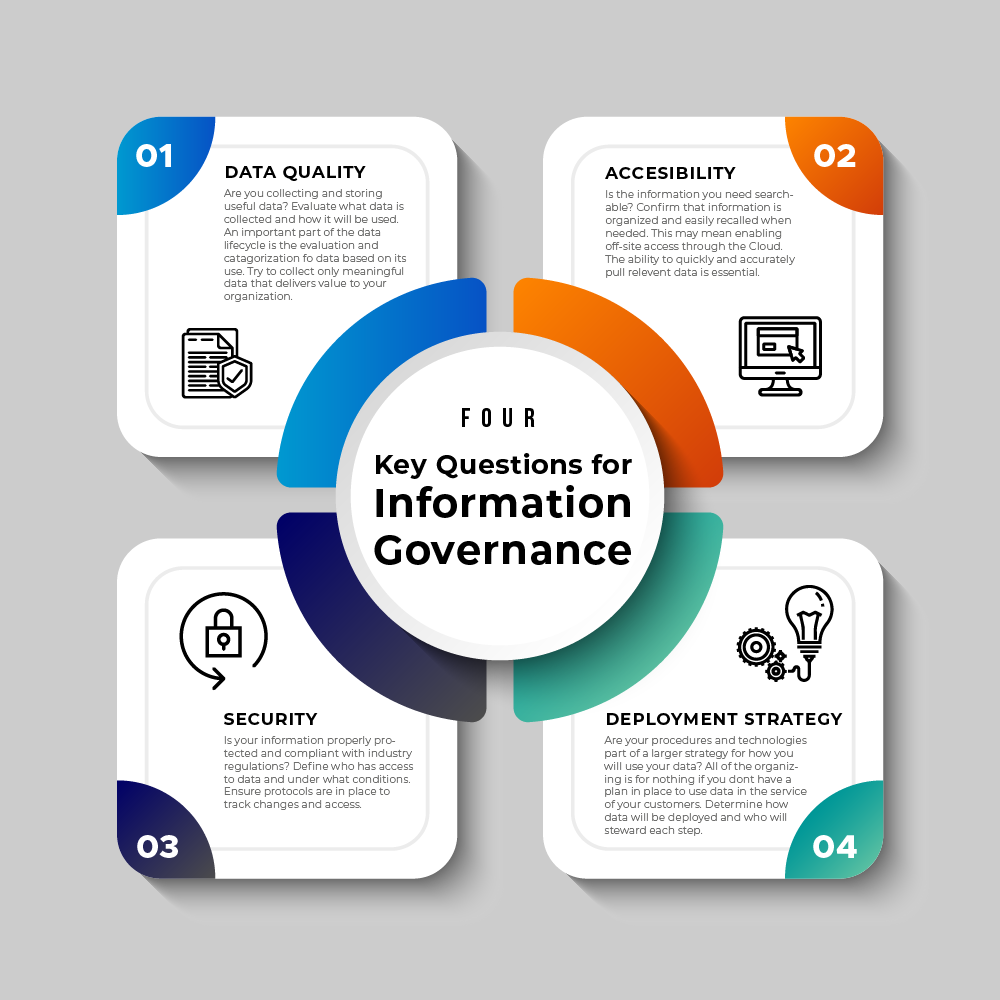What is Information Governance?
What is Information Governance and How Does it Work?
November 19, 2019
Information Governance is, at its simplest, the ongoing management strategy for information at an organization. As basic as that sounds, effective data management incorporates the integration of data analytics, cybersecurity, privacy/compliance regulations, and physical/digital records management. Ultimately, information governance is about implementing standardized procedures alongside technology to maximize the effective use of information while simultaneously reducing the risk and cost associated with managing it.
Information governance considers every part of the data lifecycle including the collection, organization, use, and security of data. There are many technologies that support an information governance strategy, but one of the most important is an organization-wide application that employees can use to access data efficiently and securely. Controlling the flow of data across your organization is vital in keeping it secure and making it accessible. In addition to a secure repository and electronic document management system, implementing clear records handling procedures keeps everything running smoothly.
“Why is Information Governance important?”
Developing a good information governance strategy can be a heavy lift for many companies, but its value cannot be overstated. The healthcare industry provides a great case study for the importance of information management. Healthcare professionals must follow HIPAA regulations and having a good information governance system in place makes compliance with those regulations easier. This includes making sure that patient information is securely stored, only accessible to authorized employees, and easily recalled in the event of an emergency. When healthcare information management (HIM) is done well it directly affects patient outcomes ensuring that care providers can make more informed diagnoses and that billing is accurate and claims processing proceeds efficiently.
Information Governance benefits aren’t exclusive to the Healthcare Industry. Business data is a valuable, money-generating asset and companies are quickly realizing that information governance is a key part of leveraging that potential.
“What does Information Governance include?”
The data that falls under information governance will depend on the specific needs of your organization or industry. Here are some examples of steps that can be included in setting up an information governance program:
- Recognize your unique data lifecycle and consider where those processes can be streamlined. Are your Employees able to access needed information? Do you have an abundance of physical files? How much collaboration is required and can your team effectively share information without compromising its security?
- Re-evaluate how information is stored. For example, if all your files are physically stored you may choose to transition to storing them on a secure content services platform (CSP) on The Cloud. This increases security and allows you to move forward with electronic form taking. Make sure to confirm you are following the compliance guidelines for your industry.
- Ensure all departments are working together to follow a unified plan for data. Every team member has a role to play. Your HR team can help train employees in proper data handing as a part of onboarding. Meanwhile, IT should focus on network security and regulatory requirements. Everyone at your organization should have a clear understanding of how to handle business data and what their part is in keeping it secure and accessible.

Information Governance Plans will vary depending on your organization, but what is important is getting a system in place to organize and control relevant data, safeguard information integrity, and ensure your organization’s compliance with regulatory law. If you are interested in learning in more detail about Compliance and Governance go to the website for the Compliance, Governance and Oversight Council (CGOC).
What can DOMA add to your organizations' Information Governance Program?
DOMA can provide your organization with the tools you need to better manage your information. If you have paper files that need to be converted to searchable digital documents we have a secure document scanning process in place that can save you time, space, and money. When documents are scanned through our system they are indexed using optical character recognition, machine learning, and robotic process automation. This ultimately means that when you need to access them digitally later down the line they will be easy to find.
We follow stringent security and compliance guidelines to make sure we can meet our customers’ compliance needs. Guidelines such as the HIPAA Regulations for safeguarding Protected Health Information (PHI) and Personal Identifiable Information (PII). All processes take place in the Amazon Web Services’ (AWS) highly secure cloud environment and we incorporate AWS’s IT infrastructure to augment our IT security standards.

Jim Fisher
director of digital services
“A key component of effective Information Governance is records availability. DOMA’s secure DX platform provides the necessary standard for where and how official records and information are stored, protected, and made available; the records retrieval process is consistent and timely, it is easy to determine where to find the authentic and final version of a record, and the process is well defined and systematic – not to mention simple and intuitive.”
Jim Fisher
Director of digital services
DOMA's Content Services Platform: DX Software
With DOMA’s DX Software, Information Governance can be customized to fit your organization. Your data is easily accessible and secure. Here are examples of some of the things you can do in our DX Software to implement your Information Governance Program:
- Customize User Access- Effectively implement Granular Access Controls by creating different user levels of access and delegate privileges for each level.
- Automate certain systems to improve workflow.
- Separate documents into different categories and file types.
- Use our Advanced Search to quickly find documents you need.
- All processes take place in the Amazon Web Services’ (AWS) highly secure cloud environment, allowing the peace of mind that your documents are secure.
As a Content Services Platform, our DX Software can help your organization effectively manage documents and add value to your Information Governance Program.
About DOMA- Powered by Tech, Driven by People
DOMA Technologies (DOMA) is a software development and digital transformation company whose mission is to change customer lives by lightening their workload through faster and more targeted access to their data. Since 2000, our team of 200+ experts has helped businesses navigate all aspects of the digital world. We are a dedicated strategic partner for the federal government and private sector clients at every stage of their unique digital transformation journey.

Author:
Danielle Wethington
Director of Communications
Digital Transformation
Learn more about Digital Transformation with DOMA Technologies
Recent News

Data-Driven Sustainability for a Healthier Future

Humanizing Healthcare

Reducing Improper Payments

